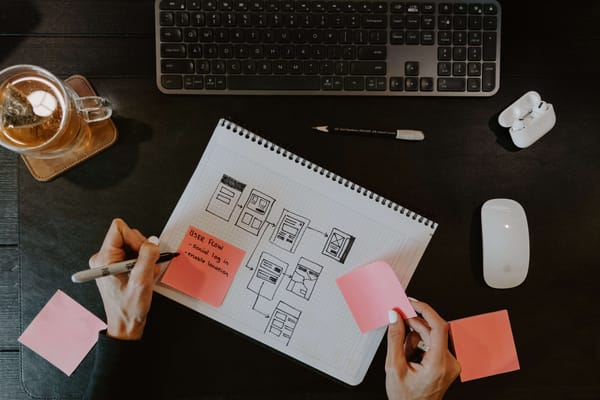Starting a new product or feature from scratch can be tricky - but prototypes are a great way to get stuck in. Here are a few ways to up your prototype game and delight your users.
What is a prototype?
Prototypes are a tool for helping stakeholders and users to visualize the product and the solution it provides. This can be useful when trying to convince stakeholders that there is value in your product.
They also help you as the developer to make the solution real and work through any of the problems that come out of the making process. This allows you to detect unintended scenarios and usability problems without spending too much time and money developing the full product.
Planning is key
It can be tempting to jump straight into designing your prototype but the easiest way to create better prototypes is to start with all the necessary information. This means doing some research and prepping before you start creating.
Set goals
To help you get started with your prototype it is important to set goals for the project. This will help you to focus your efforts while designing the prototype. Consider what problem the end product is meant to solve and how it will solve this problem.
Then consider what goals the prototype should achieve. For example, what pathways do you want to test or show in your prototype, or how accurate should the design elements be? This can help you to decide how to go about creating your prototype and what elements of it are the most important for your goals.
Competitive analysis
Understanding your competitors can also help you to have a better understanding of what your prototype should (and shouldn’t) be. This information will provide a picture of the marketplace your product will live in and understand what is expected of products within this space.
Know your audience
Designing a product without thinking about your customers is a huge mistake, they should be at the forefront of your mind at all points of the product development process - this means doing your research before starting to prototype.
You should understand who your audience is, what their goals are, and what their pain points are. This will help you to design your prototype with your users' needs in mind from the get-go.

Start with a sketch
Jumping on a computer might be your next step, but sometimes nothing beats old-fashioned pen and paper!
Starting with sketches can help you slow down and think about what needs to be done - this can help you to speed up your process later since you have already thought things through.
Here are some ideas of ways to sketch before moving to digital:
- User flows: You can use a sketch to map out how your user flows through the product and how they meet their goals.
- Info entities: What information goes into each interaction? These are the inputs and outputs of each interaction within your product.
- First sketches: Once you have these elements sketched out it will be easier to work out the basic layout of your product. Use boxes as content and draw a few thumbnails of your product’s layout to refer back to.
Prototype with purpose
When you move on to your digital prototyping, ensure you prototype with your goals in mind. This means asking yourself if each page has a purpose in the larger user flow and does it actually serve that purpose. It may also be helpful to ask if the interaction between pages makes sense - in other words, is the flow easy for users to understand?
This can help you to stay on task and only include the pages and interactions that serve a purpose and actually make sense.
Don’t be afraid to iterate
It can be easy to have an idea and stick with it till the end - but when it comes to prototyping you should experiment a little and find out what works best.
Save time later
By iterating and trying out ideas in the prototyping stage you can save time (and money) when you create the product for real as you already know what works and what doesn’t. Creating a product from scratch takes time, so knowing it definitely works before you start is a huge weight off your shoulders.
Get creative
You can also explore out-of-the-box ideas while prototyping since it’s fairly cheap to do and easy to tweak and edit. This can stop the fear that may come with being creative instead of practical.
Find the best solution
Iterating and changing your prototype can help you to discover the best solutions to your users’ problems. Through prototyping and iterating, unthought-of problems may appear in the spotlight for you to solve, and even better solutions may suddenly come to you.

Use simple techniques for complex ideas
Making the prototype more simple while still showing the complexities of your product can save you time. This means you have more time to work out any issues or iterate your design. Here are some techniques you can use to create the illusion of complexity.
Smoke and mirrors
Think of your prototype as a movie set - it’s short-lived and only needs to look right from the front end. Your prototype only has to look real, try to think of what tricks you can do to make it look like something has happened even if it hasn’t actually.
The brain will fill in the gaps of what you see - so if it looks like an image falls into a box then people are likely to assume that’s what happened. Especially those with a less technical background.
Graphical furniture
Although not everything in your prototype will be interactive you should make it feel like it is. This is where graphical furniture comes in.
Using graphical furniture means taking the non-interactive elements of your design and making them take up less space, in order to run your program more smoothly. This may mean flattening your extra user interface graphics into one image to improve performance.
Ensuring that you use a variety of graphical furniture can also make your product feel more real. Repeating one image over and over might make your prototype feel faked - so make sure to mix it up. The same goes for text: make sure it is readable and makes sense. Otherwise, it will look fake to your audience.
Fake user choices
Building a couple of choice options for your prototype users can help it to feel more realistic - and mitigate it being seen as broken because the function they went to use didn’t work.
Designing multiple options also allows you to dig deeper into elements and problems you might not have thought of otherwise. Allowing you to get more out of your prototyping process while also improving your user’s experience.
The TL;DR
The five ways to improve your prototyping are:
- Planning is key.
- Start with a sketch.
- Prototype with purpose.
- Don’t be afraid to iterate.
- Use simple techniques for complex ideas.
Each of these elements can help you to think about your audience, find the best solution to the problem, and save time when creating the final product.
Looking for more product-led growth insights? Check out our guide to all things PLG strategy - download yours now! 👇




 Follow us on LinkedIn
Follow us on LinkedIn




